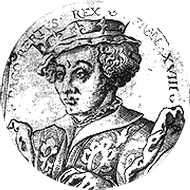He is the hero of the Chanson de Guillaume, an early chanson de geste, and of several later sequels, which were categorized by thirteenth-century poets as the geste of Garin de Monglane. Another early product of oral traditions about William is a Latin Vita ("Biography"), written before the 11th century, according to Jean Mabillon, or during the 11th century according to the Bollandist Godfrey Henschen.
William was born in northern France in the mid-8th century. He was a cousin of Charlemagne (his mother Aldana was daughter of Charles Martel) and the son of Thierry IV, Count of Autun. As a kinsman and trusted comes, he spent his youth in the court of Charlemagne. In 788, Chorso, Count of Toulouse, was captured by the Basque Adalric, and made to swear an oath of allegiance to the Duke of Gascony, Lupus II. Upon his release Charlemagne replaced him with his Frankish c
Thierry IV or Theoderic IV (c. 720 – c. 782) was a Frankish noble. Count of Autun and Toulouse; he was thought to be a son of Sigebert V, and grandson of Sigebert IV of Raze. It is now well documented that his supposed Davidic blood was a hoax (see Priory of Sion). Thierry married Auda, daughter of Charles Martel, sister of Pepin III.
- William of Gellone (755 – 28 May 812/4)
- Alda of Gellone (born ca. 770); married Fredalon
- Adalhelm of Autun
Sigebert IV (c. 671 - c. 679) was the son of Dagobert II and a Saxon duchess called Mathildis (also called Mechthilde),[1] and the grandson of Sigebert III of the Merovingian dynasty.[2][3] He is believed to have died either just before or after his father and other members of the royal family, who were killed on the orders of Ebroin, the Frankish Mayor of the Palace of Neustria.[4]
In the 10th-century biography of Saint Arbogast, Vita Sancti Argobasti,[5] Sigebert is mentioned but not named as having died during a hunting accident and later miraculously raised from the dead by Arbogast, Bishop of Strasbourg and close friend of Dagobert II.[6]
Dagobert II (Latin: Dagobertus; c. 650 – December 23, 679 AD) was the king of Austrasia (676–79), the son of Sigebert III and Chimnechild of Burgundy. He is also accounted a saint by the Roman Catholic Church; his feast day is 23 December.

Sigebert III (c. 630–656/660) was the king of Austrasia from 634 to his death; around 656–660.
He has been described as the first roi fainéant—do-nothing king—of the Merovingian dynasty.[3]
Sigebert was the eldest son of King Dagobert I and his concubine Ragnetrude and half-brother of King Clovis II.[4]

Dagobert I (Latin: Dagobertus; c. 603 – 19 January 639 AD) was the king of Austrasia (623–634), king of all the Franks (629–634), and king of Neustria and Burgundy (629–639). He was the last king of the Merovingian dynasty to wield any real royal power.[1] Dagobert was the first of the Frankish kings to be buried in the royal tombs at Saint Denis Basilica.[2]
Dagobert was the eldest son of Chlothar II and Haldetrude (575–604). Chlothar had reigned alone over all the Franks since 613. In 623, Chlothar was forced to make Dagobert king of Austrasia by the nobility of that region, who wanted a king of their own.

Chlothar II (or Chlotar, Clothar, Clotaire, Chlotochar, or Hlothar; 584–629), called the Great or the Young, was King of Neustria and King of the Franks, and the son of Chilperic I and his third wife, Fredegund. He started his reign as an infant under the regency of his mother, who was in an uneasy alliance with Clothar's uncle Guntram, King of Burgundy (d. 592). Clothar assumed full power over Neustria upon her death in 597; though rich this was one of the smallest portions of Francia. He continued his mother's feud with Queen Brunhilda of Austrasia with equal viciousness and bloodshed, finally achieving her execution in an especially brutal manner in 613, after winning the battle that enabled Chlothar to unite Francia under his rule. Like his father, he built up his territories by moving in after the deaths of other kings.
 desarrollada en entrada anterior
desarrollada en entrada anterior
No hay comentarios:
Publicar un comentario